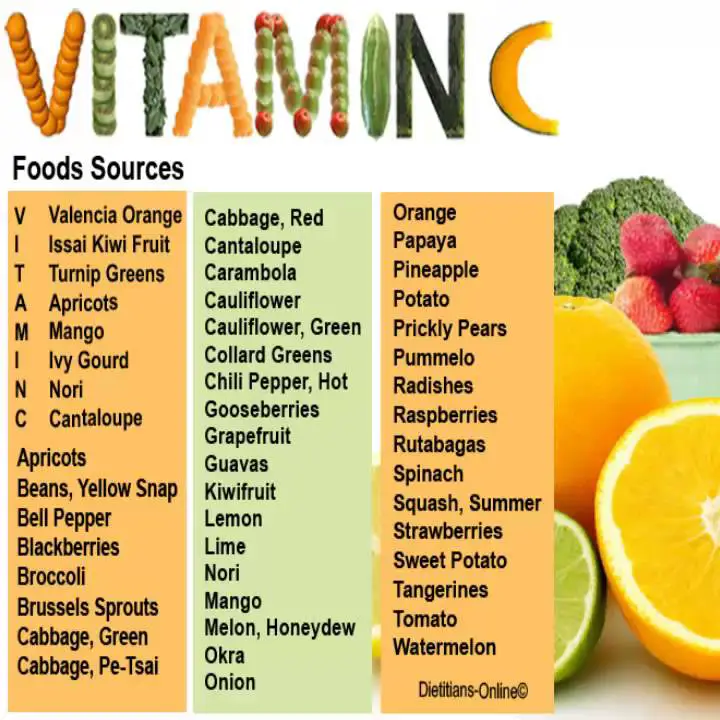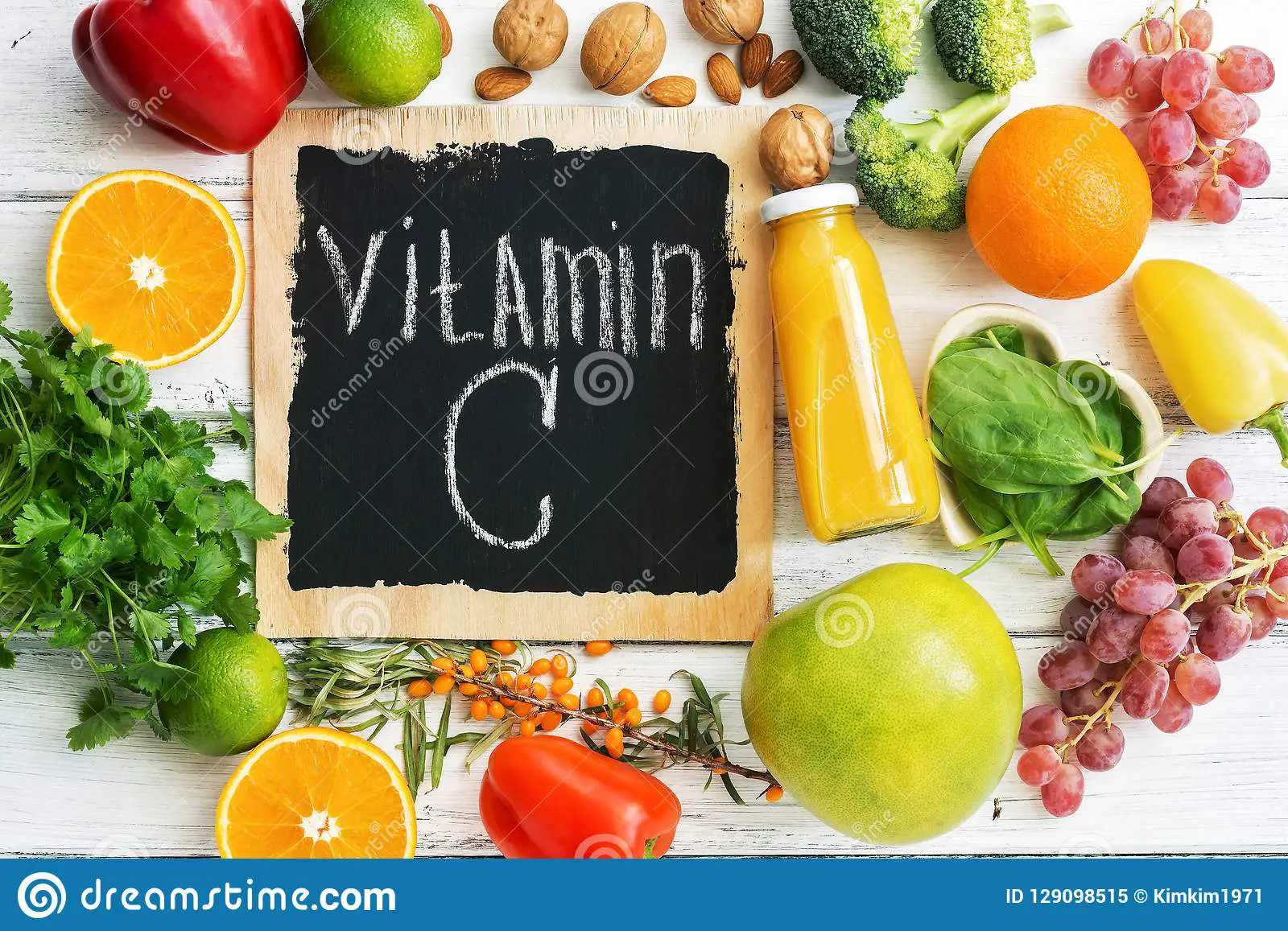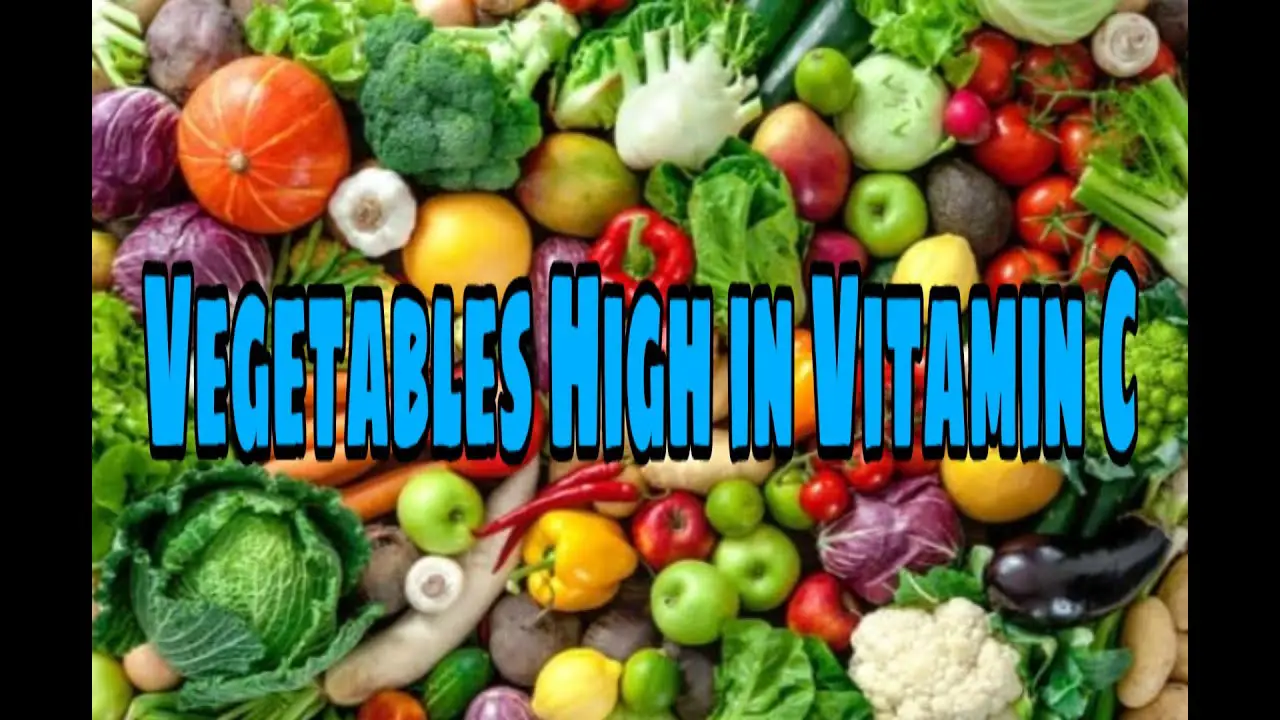Foods High In Vitamin C
1. Blackcurrants 160mg per 80g serving or 200mg per 100g
Blackcurrants are small, round, sour-tasting, deep purple-black berries which typically need some sort of sweetness added to make them more palatable. Just one 80g serving provides almost 200% of your RDA of vitamin C, and they also contain some vitamin A, calcium and iron. Blackcurrants can be easily used to make a jam or sorbet.
Discover eight ways to cook with blackcurrants.
2. Red pepper 100mg per 80g serving or 126mg per 100g
Red peppers are very versatile and can be eaten in salads or as a crudité with a dip, such as hummus or guacamole, or they can be used in soups, stews and stir-fries. Half a large red pepper contains just over the RDA of vitamin C, and also has a good amount of vitamins A, E and K as well as B6, folate and fibre.
Discover more recipes using red peppers.
3. Kiwi fruit 47mg per 80g serving or 59mg per 100g
The kiwi fruit is a bright green, tropical fruit, typically eaten raw. Simply peel and chop or cut in half and scoop out with a teaspoon. It can also be added to fruit salad, used to top yogurt or in a smoothie. A single kiwi contains just over 50% of the RDA of vitamin C and theyre also a good source of vitamin K and fibre.
4. Guava 126mg per 55g serving or 230mg per 100g serving
5. Green pepper 96mg per 80g serving or 120mg per 100g
Try using green peppers in a healthy stir-fry dish.
6. Orange 73mg per 140g serving or 52mg per 100g
Vitamin C Foods: Easy Ways To Get Your Daily Dose
Thanks to the sheer abundance of readily-available vitamin C foods, it’s never been easier to hit your daily recommended intake through your diet currently 45mg per day for adults aged 19 and older, according to the World Health Organisation. Aside from warding off scurvy, getting enough vitamin C brings a wealth of health benefits.
Vitamin C is essential for good immune function. It also plays an important role in chemical signalling and tissue repair.
‘Vitamin C is essential for good immune function,’ says Medlin. ‘It also plays an important role in chemical signalling to the brain and tissue repair. It has excellent antioxidant properties, which means that it helps to control some of the consequences of tissue damage and unhealthy lifestyle choices like drinking and smoking.’
Add the following vitamin C foods to your diet every day to bolster your overall health:
1. Papaya
Each 100g portion of this exotic fruit contains 60.9mg of vitamin C. It’s also an excellent source of vitamin A, an antioxidant vitamin that’s vital for eye health.
2. Guava
Containing a bumper 228.3mg of vitamin C in each 100g portion, it’s little wonder that guava is sometimes called a ‘super fruit’. It’s also a rich source of gut-healthy soluble fibre.
3. Chili pepper
A single chili pepper contains 6.6mg of vitamin C. Regularly eating these fiery fruits can lengthen your life, slashing your risk of death from all causes by 25 per cent, studies show.
4. Tomatoes
5. Broccoli
6. Mustard greens
What Happens If I Have Too Much Vitamin C
Vitamin C is not considered harmful and its unlikely that we get too much of it from foods alone.
However, having 3-4 times more than the recommended amount can upset our stomach and gut, causing, for example, diarrhea. Moreover, theres no evidence for an increased intake of vitamin C beyond the recommendation to result in any health benefits or consequences in healthy people.
Before taking vitamin C supplements, check with your doctor or a registered dietitian/nutritionist or consult your national dietary guideline.
Recommended Reading: Is Fish Oil Vitamins Good For You
How Much Vitamin C Do You Need Each Day
Before we dive in, a quick reminder. Vitamin C is an essential nutrient, helping to support the immune system and overall health . Adults are recommended to get around 90mg of vitamin C each day, and not to exceed 2,000mg. As it is not stored in the body, its unlikely that exceeding this dose will cause too much harm. However, taking extreme doses may cause issues such as an upset stomach, nausea, diarrhea and vomiting. Megadoses of vitamin C may also contribute to headaches . Still, you need to ensure you get at least the minimum amount its about finding the right balance. So, how do you get enough C? Lets take a look at some foods with a high vitamin C content.
Dont Ignore The Veggies

Normally, youd probably head to the fruit aisle when you want some more vitamin C.
Thats a good choice, as the most C-packed foods can usually be found there.
However, you shouldnt ignore the vegetable section completely.
In reality, there are vegetables that contain just as much ascorbic acid as fruits.A few even top the charts above popular favorites like oranges and strawberries.
In this article, well take a look at the 12 best vegetables for vitamin C.
You May Like: What Is The Best Vitamin C On The Market
Fruits And Vegetables Rich In Vitamin C
Vitamin C is also called ascorbic acid. Vitamin C has much importance, from protecting bones to building our tissue. It supports the human bodys immune system and helps your body use the iron you get from your food. Vitamin C helps in making collagen in the body. Collagen is a springy type of connective tissue. And the great news is that many fruits and vegetables rich in vitamin C benefit you with these required nutrients.
Also, this vitamin heals the wound and is an antioxidant that protects cells from damage. Men need 90 milligrams per day, and whereas women need 75 milligrams per day.
Who Is At Risk Of Vitamin C Deficiency
Vitamin C deficiency is rare, but people at a higher risk include those who:
- find it difficult to maintain a healthy diet of fresh fruit and vegetables
- smoke heavily or are dependent on alcohol or drugs
- have a health condition that makes it difficult to digest food, such as coeliac disease, ulcerative colitis or Crohn’s disease
Recommended Reading: What Vitamin Helps With Memory And Focus
The Best Sources Of Vitamin C
Which foods are rich in vitamin C and what are the benefits to our health and wellbeing? We asked nutritionist Nicola Shubrook to explain.
Vitamin C, also known as ascorbic acid, is active throughout the body. Its water-soluble, meaning it dissolves in water, and is not stored by the body, so we need to ensure we get adequate amounts from our diet everyday.
Vegetables High In Vitamin C
Vitamin C is one of the most well-known nutrients. It is a powerful antioxidant that is needed in the body for a wide range of functions these include wound healing, iron absorption, tissue repair, protecting heart health and scurvy prevention.
It is often thought that citrus fruits like lemons and oranges are the only potent sources of vitamin C. However, this is not the case there are plenty of other foods that contain a lot of vitamin C. In fact, some of the vegetables mentioned in this article contain more vitamin C than citrus fruits do, when compared weight for weight.
Below are some of the best vegetable sources of vitamin C.
Also Check: Where Can I Get Vitamin C Powder
Best Vegetables For Vitamin C
- Olivia Larsen
Are you looking to boost your vitamin C levels?
Thats a smart move.
Vitamin C, also known as ascorbic acid, is one of the most important nutrients for the human body.
Since our bodies cant produce it, we have to get the nutrient from external sources .
While severe deficiencies are rare, many people dont get enough.
Because of this, they miss out on the juiciest benefits that big C has to offer.
Persistent Iron Deficiency Anemia
Vitamin C and iron deficiency anemia often occur together.
Signs of iron deficiency anemia include paleness, fatigue, trouble breathing during exercise, dry skin and hair, headache and spoon-shaped fingernails .
Low levels of vitamin C may contribute to iron deficiency anemia by reducing the absorption of iron from plant-based foods and negatively affecting iron metabolism (
45 ).
While fatigue and irritability may be some of the first symptoms to appear, they typically resolve after just a few days of adequate intake or within 24 hours of high-dose supplementation .
Summary Signs of fatigue and poor mood can appear even with low-to-normal levels of vitamin C, but they quickly turn around with adequate vitamin C intake.
Recommended Reading: Which Vitamin Is Good For Immunity
What Does Science Say About Vitamin C For Specific Health Conditions
Theres no disputing vitamin C is a vital compound needed for the healthy functioning of our bodies. There is an ever-growing list of afflictions and conditions vitamin C is suggested to improve or prevent, but not all are backed by science, including:
Vitamin C might help to decrease the duration of a cold, but taking it preventively the research doesnt necessarily support that, she says. A study published in the Cochrane Database of Systematic Reviews found that high doses of vitamin C may reduce the duration of a cold, but did not have an impact on preventing or reducing the symptoms of a cold.
One thing Moore says there is evidence for is vitamin C does help the body absorb more iron from food, especially nonheme iron from meat-free food sources. Pairing vitamin Crich foods with iron-rich foods for example, spinach with orange segments, or black beans with salsa is especially important for people who are vegan, vegetarian, or anemic, and for women of childbearing age, Moore says.
RELATED: 10 Foods That May Help Prevent Cancer
Fruits That Are High In Vitamin C

- Kiwi One kiwi has 72 mg of vitamin C, 80 percent of the DV.
- Guava One guava fruit has 125 mg of vitamin C, or 139 percent of the DV.
- Blackberries One cup of blackberries has 30 mg of vitamin C, or 33 percent of the DV.
- Papaya One large papaya has 475 mg of vitamin C, which is 527 percent of the DV.
- Lemons and Limes One lime has 19 mg of vitamin C, or 21 percent of the DV.
- Strawberries One cup of sliced strawberries has 97 mg of vitamin C, or 107 percent of the DV.
- Oranges One orange has 112 mg of vitamin C, or 124 percent of the DV.
RELATED: 5 Tricks for Getting Enough Fruit and Veggies
Read Also: How Long Does It Take To Restore Vitamin D Levels
Toxicity Of Vitamin C
Being a water-soluble vitamin, Vitamin C easily excreted through urine. Hence there are fewer chances of any adverse effects. Higher doses of Vitamin C may cause diarrhea, nausea, vomiting, stomach pain, and headache.
It essential to include Vitamin C in your diet as it is a very important nutrient to keep your body fit. There are several benefits of Vitamin C from a simple cold to serious cancer. Hence, considering Vitamin C can be a great investment in your well-being. Also, make sure to consult your physician before initiation of your diet or taking other supplements.
Vitamin A Rich Vegetables You Should Tank Up On
Vitamin A is a fat-soluble vitamin that your body needs for good vision and healthy skeletal tissue, teeth, skin, soft tissue and mucous membranes.1 It also keeps your reproductive system, immune system, heart, kidneys, and lungs working well.2
A vitamin A deficiency is something you dont want to reckon with. From night blindness and dry/itchy eyes to lowered immunity and skin and hair problems, it opens up a Pandoras box. The good news is that our vitamin A requirements can easily be met with just normal, everyday intake of nutritious food. And theres no cause to worry if you are vegetarian or vegan. Many vegetables have this crucial vitamin and incorporating them into your daily diet isnt as complicated as you may think.
Recommended Reading: What’s A Good Vitamin To Take For Energy
Recommended Intake Of Vitamin A Is 900 Mcg Rae
Vegetables contain carotenoids . which your body converts into vitamin A. Vegetarian sources of vitamin A may not be absorbed as efficiently as the animal-derived forms of vitamin A. But they are an inexpensive source and wont cause toxicity from excessive intake. Just be sure to have a variety of vitamin A-rich food and youll meet your requirements without a glitch.3
The ideal intake of vitamin A varies based on your age, gender, and even whether youre pregnant or nursing.
- Adults and children above 4 years should, in general, have 900 mcg RAE.
- If you have a baby on board or are lactating, you need 1,300 mcg RAE.
- Children aged 13 years need 300 mcg RAE.
The recommended intakes are measured in mcg of retinol activity equivalents . This measure factors in differences between the bioactivity of retinol versus provitamin A carotenoids.45
Heres a look at the richest food sources of vitamin A. The % daily value indicates how much of your daily value the food delivers. DV is a measure of richness in the nutrient and is pegged at 900mcg RAE for the calculations below. Usually, a number of 20% or more indicates a very high source.6 The values are for a standard serving of the food.
- 1 baked sweet potato with skin: 1,403 mcg RAE
- Half a cup of boiled sweet potatoes: 1,290 mcg RAE
How Can You Get More Vitamin C Into Your Diet
You can always use vitamin C supplements for an extra boost, but both Kirkpatrick and Glassman recommend getting vitamin C from food sources whenever possible.
“The best source of that we see is really coming from different types of foods, mainly fruits and vegetables,” Kirkpatrick said. Here is a list of some of the best vitamin C foods.
These veggies and fruits are good sources of vitamin C:
- Red bell peppers
- Cruciferous veggies
- Potatoes
Read Also: Where Can You Buy Usana Vitamins
Why Include Vitamin C In Your Garden
Vitamin C is an essential nutrient as we all know it is needed for keeping cells healthy and for boosting the immune system. What you might not know, though, is how much of this vitamin is lost when fresh foods are processed. Both canned and frozen vegetables have lost significant amounts of vitamin C by the time they get to your kitchen.
Even fresh produce loses vitamin C while stored. That means that when you buy fresh broccoli from the grocery store, by the time you eat it, it could have lost up to half of its vitamin C. By growing vegetables for vitamin C, you can harvest and eat them right away, losing little of this important nutrient.
Leafy Greens And The Family Brassicaceae
Take 1/2 cup of cabbage leaves out of your freezer, and boil them for dinner that’s 25 mg of vitamin C right there. Eat a cup of chopped raw cabbage–about 89 grams–and you’ll get 32.6 mg vitamin C.
Kohlrabi contains 15.1 mg vitamin C per ounce boiled and 17.4 mg per ounce raw.
An ounce of chopped raw broccoli contains 25 mg of vitamin C. Boil that same ounce and the vitamin C content drops to 18.2 mg.
An ounce of raw spinach has 7.9 mg of vitamin C. Boil it and it drops to 2.7 mg.
Read Also: How Does Vitamin C Help
Top 10 Foods Highest In Vitamin C
Vitamin C is an essential nutrient required for the maintenance of skin, blood vessels, bones and cartilage, and wound healing.
Vitamin C also helps protect cells against oxidative stress, which in turn provides protection against certain diseases, including cancer.
Vitamin C, like zinc and vitamin A, also helps support your immune system.
High vitamin C foods include guavas, bell peppers, kiwifruit, strawberries, oranges, papayas, broccoli, tomatoes, kale, and snow peas. The current daily value for vitamin C is 90mg.
Below is a list high vitamin C foods ranked by a common serving size, use the nutrient ranking of over 200 foods high in vitamin C to see the foods highest in vitamin C by nutrient density , or see rankings of fruits high in vitamin C, and vegetables high in vitamin C.
What Are The Best High Vitamin C Vegetables

12 Best Vegetables For Vitamin C Sweet Yellow Pepper. Coming in at a strong number one, sweet yellow pepper is your best bet if you want a vitamin-C rich vegetable. Chili Pepper. Right behind its sweeter, yellow relative comes the hot-and-spicy chili pepper. Red Bell Pepper. Yes, its another pepper! Kale. Broccoli. Brussel Sprouts. Green Bell Pepper. Kohlrabi. Cauliflower. Spinach. More items
Recommended Reading: What’s The Recommended Dose Of Vitamin C
How Much Vitamin C Do I Need Per Day
How much vitamin C you need per day changes according to your age, sex and life-stage.
The DRV* set for healthy adults is between 95-110 mg of vitamin C per day. During pregnancy and lactation, needs can go up to 105 mg and 155 mg of vitamin C per day, respectively.
We can get enough vitamin C from our diets by eating a variety of foods. Following your country’s dietary guidelines on a healthy and balanced diet will help you meet your needs for vitamin C.
* These values are based on the population reference intake estimates from European Food Safety Authority . They should not be interpreted as nutrient goals. To know more about dietary reference values in Europe .